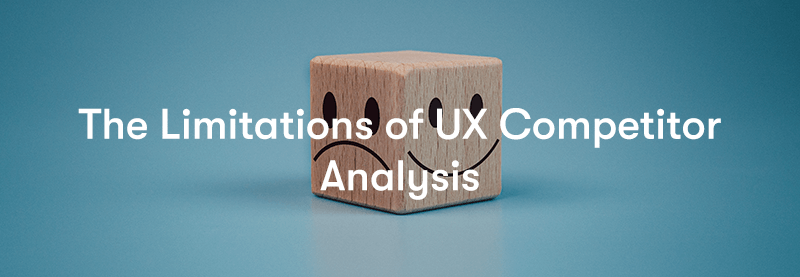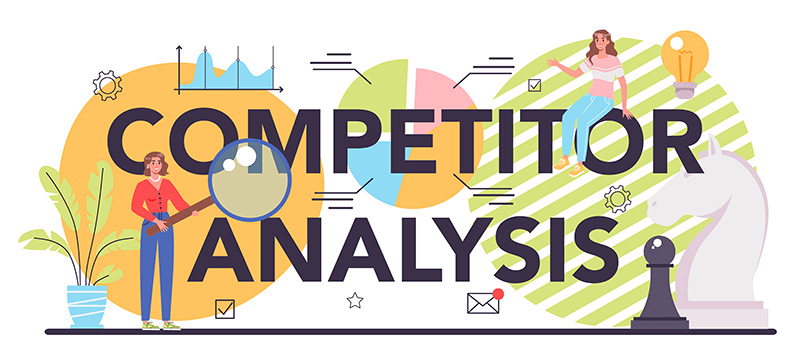UX Competitor Analysis
UX (User Experience) Competitor Analysis; this systematic exploration unveils insights into how competitors address user needs, their design strengths, and areas where they falter. In this blog, we will explain the journey of dissection and evaluation aimed at understanding the intricacies of competitors' products and services. Armed with these insights, we can refine our strategies, enhance user satisfaction, and remain at the forefront of design innovation. Let us dive straight into the world of UX Competitor Analysis.
What is UX Competitor Analysis?

UX Competitor Analysis is a process in which businesses and designers evaluate and compare the user experiences provided by their competitors' products or services. The primary goal of this analysis is to gain insights into how competitors are meeting the needs and expectations of their users, identifying strengths and weaknesses, and using this information to improve their own user experiences.
The Benefits of UX Competitor Analysis
UX Competitor Analysis offers several significant benefits for businesses and designers aiming to improve their products and services:
Understanding User Expectations
By analysing competitors, you gain insights into what users expect from products or services in your industry. This understanding helps you align your design and functionality with user needs and preferences.
Identifying Strengths and Weaknesses
Evaluating competitors allows you to identify areas where they excel and fall short. This information helps you capitalise on their weaknesses and differentiate your offering based on your strengths.
Benchmarking Performance
Competitor analysis provides a benchmark for assessing your product's performance. You can measure your user experience against industry standards and identify areas where you must catch up or exceed competitors.
Reducing Design Risks
Learning from competitors' successes and failures can reduce design and development risks. You can avoid common pitfalls and design choices that may negatively impact user satisfaction.
Enhancing Innovation
Analysing competitors can inspire new ideas and innovations. You might discover features, design elements, or strategies you hadn't considered, leading to creative solutions that set your product apart.
Fostering Continuous Improvement
Competitor analysis is not a one-time task. It encourages a culture of continuous improvement by regularly evaluating the competitive landscape and making iterative enhancements to your product.
Improving Usability
By uncovering usability issues in your competitors' products, you can proactively address similar problems in your design. This can lead to a more user-friendly experience and higher user satisfaction.
Optimising Resource Allocation
Insights from competitor analysis can help you allocate resources more effectively. You can prioritise development efforts on areas most likely to positively impact the user experience and provide a competitive advantage.
Enhancing Brand Reputation
A better user experience can contribute to a positive brand image. Users are more likely to have favourable opinions of your brand if they have a seamless and enjoyable experience with your product.
Increasing Customer Retention
When your product provides a superior user experience compared to competitors, you are more likely to retain existing customers and attract new ones. Satisfied users are less likely to switch to competing products.
Informing Marketing Strategies
Understanding your competitors' user experiences can inform your marketing strategies. You can highlight the areas where your product excels and use this as a competitive advantage in your marketing campaigns.
Data-Driven Decision Making
Competitor analysis provides data and evidence to support decision making. It helps you make informed choices about design, feature prioritisation, and overall product strategy.
In summary, UX Competitor Analysis is a valuable practice that helps businesses stay competitive, meet user expectations, and continually improve their products or services. It fosters a user-centric approach to design and development, ultimately leading to higher user satisfaction and business success.
The Limitations of UX Competitor Analysis

While UX Competitor Analysis is a valuable process, it has certain limitations that should be considered:
Limited Access
You may not have access to all the necessary data about your competitors' products or services. Some features and aspects of their user experiences may be hidden or restricted from public view, making it challenging to conduct a comprehensive analysis.
Contextual Differences
Competitor products may target a different user demographic or serve a different purpose, making direct comparisons less meaningful. It's essential to consider these contextual differences when interpreting your findings.
Subjectivity
UX analysis involves subjective judgments about the user experience. What one person finds user-friendly, another may not. This subjectivity can introduce bias into your analysis.
Incomplete Picture
Relying solely on competitor analysis may provide an incomplete picture of the user experience. You may not fully understand the user's journey, motivations, or pain points without conducting user research on your own product.
Static Data
Competitor analysis captures a snapshot of your competitors' products at a specific time. User experiences can change rapidly due to updates and iterations, so the data may quickly become outdated.
Lack of User Feedback
Your analysis may not capture the most up-to-date user feedback and reviews. User sentiment can change over time, and recent feedback can reveal evolving user preferences and issues.
Copying vs Innovation
A strict focus on competitors can lead to a "copycat" mentality, where you mimic their features without considering what truly benefits your users. This approach may stifle innovation and differentiation.
Limited Perspective
Competitor analysis may not provide a holistic view of the competitive landscape. You might miss smaller, emerging competitors or underestimate indirect competitors offering alternative solutions to the user's needs.
Assumption of Success
Just because a competitor has a particular feature or design doesn't mean it's successful or well-received by users. It's essential to validate assumptions through user testing and feedback.
Overemphasis on Surface-Level Aspects
Competitor analysis often focuses on a user interface's visual and functional aspects. It may miss deeper, systemic issues that affect the overall user experience.
Missing Internal Insights
External analysis doesn't provide insights into your organisation's capabilities, goals, and constraints. What works for a competitor may not align with your internal resources or business strategy.
Neglecting Long-Term Vision
Relying solely on competitors may lead to a short-term focus on matching their features and designs. Balancing this with a long-term vision for your product's evolution is important.
To mitigate these limitations, it's essential to complement UX Competitor Analysis with other research methods, such as user interviews, usability testing, and user surveys, to better understand your users and their needs. Regularly revisiting your analysis to stay up-to-date with the changing competitive landscape is crucial for effective decision-making and innovation.
When to Start UX Competitor Analysis?

Competitor analysis is an essential component of the UX design process, and it typically fits in at various stages to inform and enhance the overall user-centred design approach. Here's how competitor analysis can be integrated into the UX process:
Discovery and Research Phase
Identifying Competitors: The process often begins with identifying key competitors in the market. This can be done early in the discovery phase when conducting market research.
Gathering Initial Insights: Initial insights into competitor products and user experiences can be collected during this phase, helping to shape the direction of your research and design efforts.
User Research Phase
Understanding User Expectations: Competitor analysis can help inform the creation of user personas by providing insights into what users expect from products or services in your industry.
Refining Research Objectives: By analysing competitor products, you can refine your research objectives and focus on areas identified as significant based on competitor strengths and weaknesses.
Design and Ideation Phase
Inspiration and Ideation: Insights from competitor analysis can inspire new design ideas and solutions. You can explore innovative approaches that set your product apart while addressing the shortcomings of competitors.
Feature Prioritisation: Based on your analysis, you can prioritise features and design elements that align with user needs and offer a competitive advantage.
Usability Testing and Evaluation Phase
Validation of Findings: During usability testing, you can validate or refute your initial findings from competitor analysis. Real users' interactions with your product will reveal whether your design choices are effective.
Iterative Improvement: Any issues or pain points identified in competitor products can be used as a benchmark for your usability testing. You can aim to provide a better user experience.
Iterative Design and Development
Continuous Improvement: Competitor analysis isn't a one-time task. It should be an ongoing process that informs continuous design and development iterations. As you release updates, you can compare your product's new features and improvements to those of competitors.
Adapting to Changes: Keep an eye on the competitive landscape, as competitors may update or release new products. Be ready to adapt your design and development strategy accordingly.
Post-Launch Monitoring and Optimisation
Monitoring User Feedback: After launching your product, ongoing competitor analysis can help you monitor user feedback, reviews, and ratings on your competitors' products to identify evolving user preferences and issues.
Optimisation: Use the insights gained from competitor analysis to optimise your product over time. This might involve refining features, improving usability, or addressing newly identified user needs.
Competitor analysis is not a one-off activity but rather an integral part of the entire UX design process. It provides valuable insights at various stages, from initial research and ideation to usability testing and ongoing optimisation. By continually assessing the competitive landscape, you can create a user-centred design that meets user expectations and maintains a competitive edge in the market.
How to Conduct UX Competitor Analysis

Conducting a UX Competitor Analysis involves a structured approach to gather, analyse, and interpret information about your competitors' products or services. Here are the steps to conduct a UX Competitor Analysis effectively:
Identify Competitors
List the main competitors in your industry or niche. These can be direct competitors offering similar products or services or indirect competitors addressing similar user needs.
Set Clear Goals and Objectives
Define what you aim to achieve with the analysis. Are you looking to identify usability issues, evaluate design elements, or understand user engagement strategies? Setting clear objectives will guide your analysis.
Select Competitor Products
Choose the specific products or services you want to analyse from your competitors. It's often best to focus on their flagship or most relevant offerings.
Gather Information
Collect data and information about your selected competitors. This can include:
- User interfaces (websites, apps, physical products).
- Features and functionalities.
- Content organisation and presentation.
- Visual design elements (colours, typography, imagery).
- User flows and navigation.
- Loading times and performance.
- Accessibility features (if applicable).
- User feedback and reviews.
Create User Personas
Develop user personas or profiles that represent your target audience. Understanding your users' needs and preferences will help you evaluate competitor experiences from their perspective.
Evaluate User Journeys
Map out everyday user journeys or tasks that users would perform on your competitors' products. This might include making a purchase, signing up, or finding information.
Use Competitor Products
Interact with the selected competitor products as if you were a typical user. Go through the identified user journeys and tasks to experience their user interfaces firsthand.
Usability Testing
Consider conducting usability testing on your competitors' products with real users. This can provide valuable insights into specific usability issues and user frustrations.
Document Findings
Create a detailed report or document that summarises your findings. Include screenshots, notes, and annotations to highlight specific areas of interest or concern.
Identify Strengths and Weaknesses
Based on your analysis, identify the strengths and weaknesses of each competitor's user experience. Note what they do well and where they fall short in meeting user needs.
Compare Against Your Goals
Evaluate how well each competitor's user experience aligns with your predefined goals and objectives. Determine which aspects are most important to your users and your business.
Prioritise Findings
Rank the identified issues or areas for improvement based on their impact on the user experience and alignment with your goals. Prioritise the most critical findings.
Generate Insights
Extract critical insights and actionable takeaways from your analysis. These insights should inform your own design and development decisions.
Apply Findings to Your Product
Use the insights from competitor analysis to make informed design and usability improvements to your product or service. Implement changes that address user needs and provide a competitive advantage.
Iterate and Monitor
Continue to monitor your competitors and iterate on your product as needed. User preferences and the competitive landscape can change, so ongoing analysis is essential.
Share Findings
Share the results of your competitor analysis with relevant team members, stakeholders, and decision-makers. Ensure that the insights are used to drive design and business decisions.
Remember that UX Competitor Analysis is not a one-time activity but an ongoing process to help you stay competitive and continually enhance your user experience. Regularly revisit your analysis to adapt to changes in the market and evolving user expectations.
Where to Learn More about UX?
Our BCS Foundation Certificate In User Experience training course is perfect for anyone who wants to increase their knowledge of User Experience. The BCS User Experience course will teach you the UX methodology, best practices, techniques, and a strategy for creating a successful user experience. The course will cover the following topics:
- Guiding Principles
- User Research
- Illustrating The Context Of Use
- Measuring Usability
- Information Architecture
- Interaction Design
- Visual Design
- User Interface Prototyping
- Usability Evaluation
Click the button below to find out more.

Final Notes on UX Competitor Analysis
In the world of UX design, staying competitive is a continuous journey. UX Competitor Analysis can be your quick and easy weapon for success. This process offers valuable insights at every turn, from identifying rivals to evaluating user journeys.
You can shape a superior user experience, prioritise improvements, and innovate intelligently by learning from others. Remember, it's not a one-and-done task. It's a dynamic process that evolves with your product and the ever-changing landscape. So, dive into the world of UX Competitor Analysis, and let your user-centred design lead you to greater heights!



